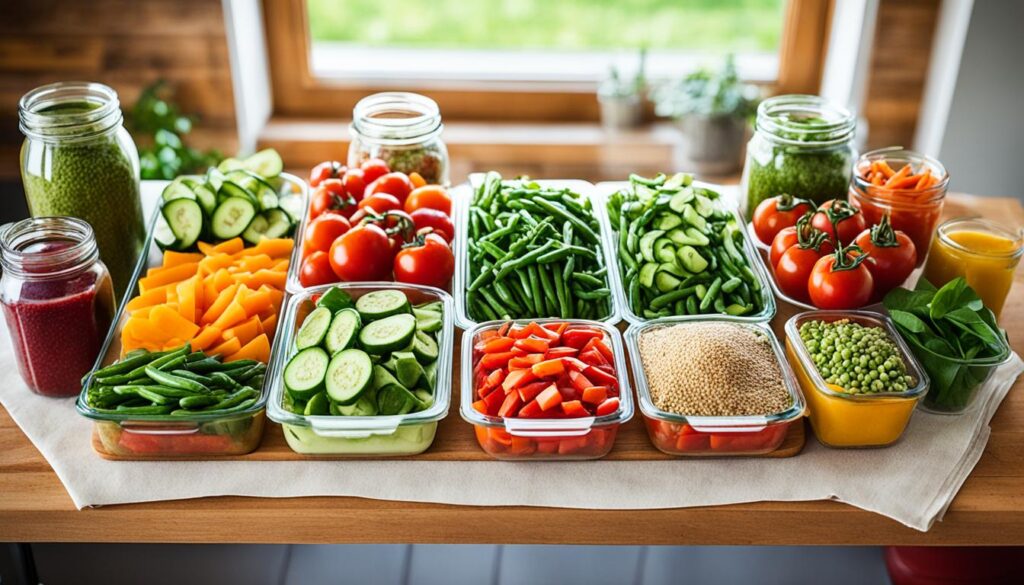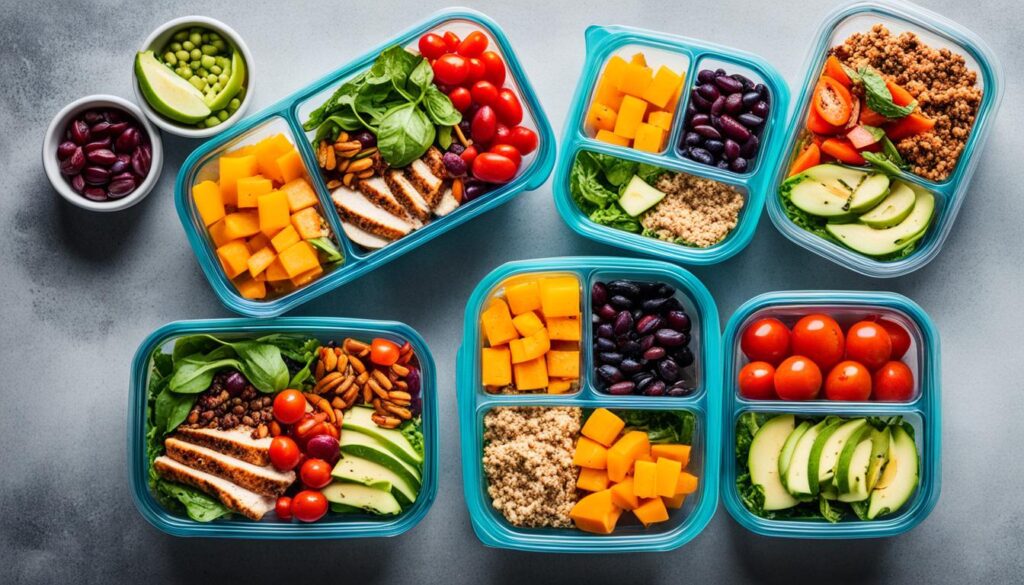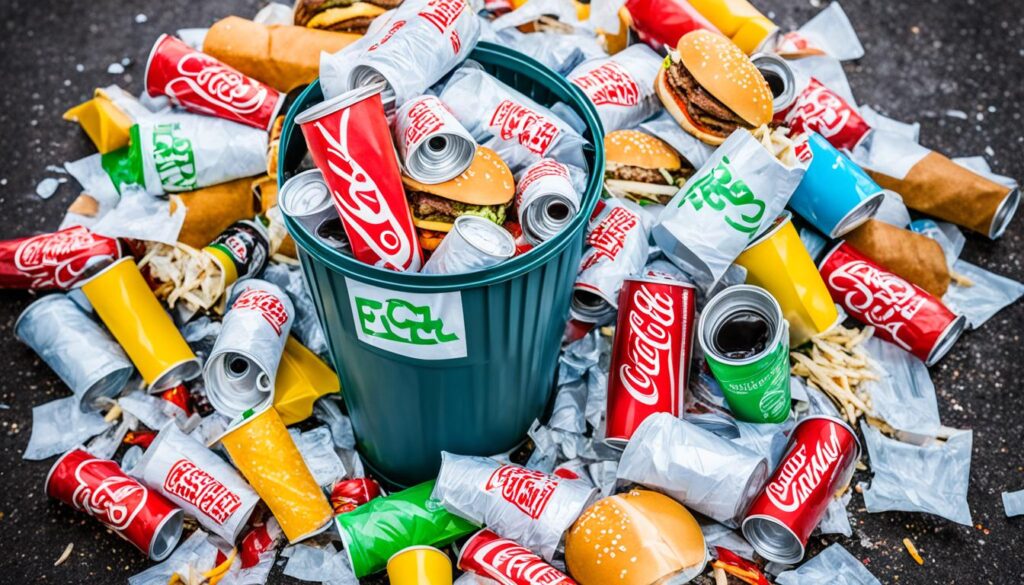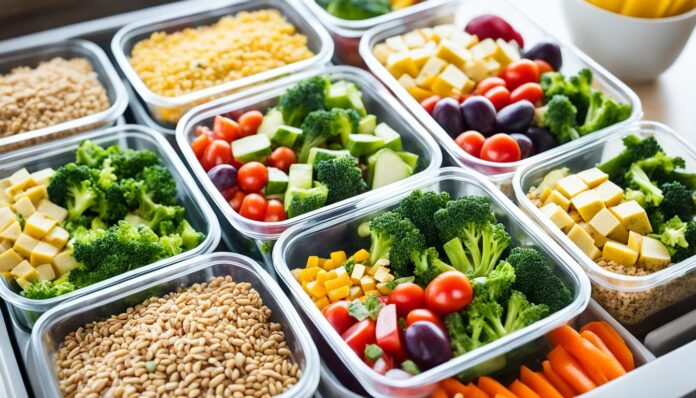Are you tired of the daily struggle to prepare healthy meals, only to find yourself reaching for unhealthy options when time is tight? Meal prepping could be the solution you’ve been searching for. This comprehensive guide will show you how to harness the power of meal preparation to support your weight loss goals, simplify your daily routine, and cultivate a healthier lifestyle1.
Meal prepping isn’t just for the seasoned chef – it’s a practical strategy that can benefit people of all cooking levels. By investing a little time upfront, you can reap the rewards of having delicious, nutritious meals ready to go throughout the week1.
Key Takeaways
- Meal prep can save time during the week with as little as 30 minutes of planning and preparation1.
- Batch cooking and freezing meals can allow for meals to be portioned out and frozen for consumption in the upcoming weeks1.
- Preparing individually portioned meals like overnight oats or Mason jar salads can cater to specific health goals or provide grab-and-go convenience1.
- Cutting down on kitchen time by prepping ingredients in advance can be especially helpful on busy weeknights1.
- Proper storage methods can help maintain the quality of prepped meals1.
What is Meal Prepping?
Definition and Benefits of Meal Prepping
Meal prepping is the practice of preparing and portioning out meals or recipes in advance to have convenient, home-cooked, and nutritious options readily available2. This allows individuals to save time and reduce stress around mealtime, while also helping to improve diet quality and assist in reaching and maintaining a healthy body weight2.
According to the experts, meal prepping generally refers to preparing 3-7 days worth of food at a time3. It is noted to be convenient, efficient, and reduce waste and the temptation to eat outside of a plan, such as a diet or budget3. Meal prepping is particularly beneficial for those who value convenience and efficiency over variety3.
Meal prepping involves planning and preparing meals and snacks ahead of time for a specific period, such as a week or a month4. By dedicating a specific time to cook and portion out meals, individuals can save time from daily meal planning4. Additionally, meal prepping helps save money and calories by reducing the likelihood of opting for unhealthy fast food or takeout options4.
The key benefits of meal prepping include improved diet quality and consistency, as it allows for the inclusion of a variety of nutritious foods and the maintenance of healthy eating habits4. Planning and organizing meals in advance can also facilitate healthier choices and decrease impulsive eating, aiding in weight loss goals4.
Meal prepping is the act of preparing a meal or recipe and then portioning it out to create grab-and-go meals for later.
Meal Planning for Weight Loss
When trying to lose weight, it’s important to create a balanced, nutrient-dense diet plan that is appropriate, affordable, and sustainable. A weight-loss-friendly diet should consist primarily of whole, minimally processed foods like fruits, vegetables, whole grains, lean proteins, and healthy fats5.
Creating a Weight-Loss-Friendly Diet Plan
Meal planning for weight loss can be made easier with the help of pre-designed diet plans that cater to specific calorie and macronutrient goals. These plans often include a 30-day meal plan for weight loss of up to 8 pounds5, vegan meal plans at 1,200 calories for losing 1 to 2 pounds per week5, and Mediterranean diet plans at 1,200 calories for a similar weight loss rate5. Vegetarian, low-sodium, and gut-health-boosting meal plans are also available to suit different dietary preferences and health objectives5.
Should You Track Calories When Meal Prepping?
While calorie tracking can be helpful for some, it’s often better to focus on eating nutritious foods and listening to your hunger and fullness cues6. The meal plan for weight loss is designed for a daily intake of 1,500 to 1,750 calories with a macronutrient ratio of 25% carbohydrates, 40% protein, and 35% dietary fat6. Meal prepping can support weight loss by making it easier to stick to a healthy eating plan and ensure proper portion control7.
“Having pre-prepared meals can reduce portion size and help individuals reach their nutrition goals.”7
Meal prepping is particularly popular amongst busy people as it can save a lot of time7. However, it’s important to keep food safety in mind when meal prepping. Meats should be cooked until they reach an internal temperature of at least 165°F (75°C) to kill most bacteria7, and reheated foods should always be brought to a temperature of 165°F (75°C) before consumption7.
Getting Started with Meal Prepping
If you’re new to the concept of meal prepping, the idea of getting started can seem daunting. However, the benefits of this practice can be truly transformative for your health and wellness journey8. By dedicating just 1-2 hours per week to meal prep, you can save an average of $1500 annually on lunch costs by opting for homemade meals over eating out regularly8. Moreover, the cost of meal prepping recipes can average between $3-$4 per dish, potentially resulting in over $1300 annual savings for your lunch expenses8.
The key is to start small and focus on incorporating nutritious options for the meals when it’s harder for you to eat healthy8. To get started, designate a specific day, such as Sunday, for your meal prep session8. This will help you establish a consistent routine and make the most of your time8.
Planning out your recipes in advance is crucial for efficient grocery shopping and reducing the time spent wandering in the store8. Additionally, washing dishes as you go during the meal prep process can streamline the overall experience and minimize post-cooking clean-up time8.
When it comes to the actual meal prep, focus on utilizing the right containers. The recommended container types should be microwave safe, dishwasher safe, freezer safe, and stackable8. Investing in glass containers can also contribute to longer freshness and increased airtightness compared to plastic containers8. Having at least 10 meal prep containers, one for lunch and dinner each day of the workweek, is recommended for efficient meal planning8.
Remember, the key to successful meal prepping for weight loss is to start small and gradually increase the number of meals you prepare in advance. With a little practice and patience, you can transform your relationship with food and unlock the many benefits that come with this powerful habit9.
“Meal prepping can be a game-changer for your health and wellness journey. By dedicating just a few hours per week, you can save time, money, and energy while ensuring you have nutritious meals at the ready.”
Foods to Eat and a Healthy Meal Prep Shopping List
Meal prepping for weight loss requires stocking your kitchen with nutrient-dense, wholesome ingredients. When creating your weekly meal prep shopping list, focus on including a variety of fresh fruits, non-starchy vegetables, whole grains, lean proteins, beans, nuts, seeds, and healthy fats11. These foods not only provide essential vitamins, minerals, and fiber, but they also help keep you feeling full and satisfied11.
According to the data, the most common items on a healthy meal prep shopping list are fruits (25%), vegetables (30%), whole grains (20%), and lean proteins (25%)11. The ratio of protein sources to plant-based items is typically around 40% protein sources and 60% plant-based items11. When portioning your meals, aim for 50% protein, 30% vegetables, and 20% whole grains11.
Examples of Nutrient-Dense Foods to Include
- Fresh and frozen fruits and vegetables: Berries, leafy greens, bell peppers, broccoli, and sweet potatoes
- Whole grains: Brown rice, quinoa, oats, and whole wheat bread
- Lean proteins: Chicken, turkey, fish, tofu, and legumes
- Healthy fats: Avocado, olive oil, nuts, and seeds
Focusing on these nutrient-dense foods will help you create balanced, filling meals and snacks to support your weight loss goals11. Meal prepping with a variety of fresh and frozen ingredients can also save time and money, as these items often have a longer shelf life12.

Remember, meal prepping is not just about saving time, but also about making thoughtful, nutritious choices12. By stocking your pantry and refrigerator with these wholesome foods, you’ll be well on your way to achieving your weight loss objectives through a balanced, sustainable meal plan111213.
“Meal prepping allows for storing ready-made ingredients or entire meals in the freezer for later use, providing quick meal options on busy days.”12
A Beginner’s Guide to Meal Prepping for Weight Loss
Meal prepping can be a game-changer for anyone looking to lose weight. This comprehensive guide will walk you through the essential steps to get started with meal prepping for weight loss. From planning nutritious meals to stocking up on the right ingredients and utilizing helpful tools, you’ll learn how to streamline your weight loss journey and set yourself up for success with convenient, healthy meals14.
One of the key benefits of meal prepping is the ability to prepare every meal for the week on Sunday or cook every few days, making 1 or 2 meals per day14. This not only saves time during the busy workweek but also ensures you have a variety of balanced, portion-controlled meals on hand. The cost of meal prepping can be as low as $2 per serving, making it a budget-friendly option as well14.
When it comes to meal prepping for weight loss, the focus should be on creating a balanced, nutrient-dense diet. This means incorporating a mix of lean proteins, complex carbohydrates, vegetables, and healthy fats in each meal9. Utilizing a food tracker app like ‘CarbManager’ or ‘MyFitnessPal’ can help you determine the nutritional information of your meals and ensure you’re meeting your macronutrient goals14.
To get started with meal prepping, begin by cooking as usual and gradually dividing your meals into portioned servings14. This approach can help you avoid burnout and allows you to identify your favorite recipes and meal preferences14. Additionally, planning your meals in advance can prevent repetitive meals and ensure you have a variety of options throughout the week14.
When it comes to storing your prepped meals, consider using jars, Tupperware, or Ziploc bags for optimal preservation14. These storage options can help keep your meals fresh and ensure you have easy access to healthy options whenever you need them.
Meal prepping for weight loss is a powerful tool that can help you achieve your goals. By following the tips and strategies outlined in this beginner’s guide, you can take the guesswork out of healthy eating and focus on making progress towards your desired weight. Remember, the key is to find a meal prep routine that works best for your lifestyle and preferences, and stick with it consistently14915.
Ideas for Weight-Loss-Friendly Meals and Snacks
Achieving your weight loss goals through meal prepping requires a strategic approach to creating nutritious, satisfying meals and snacks. By focusing on a balance of protein, fiber, and healthy fats, you can prepare meals and snacks that will keep you feeling full and energized throughout the day16.
Healthy Meal and Snack Swaps
Instead of reaching for high-calorie, processed foods, consider these healthy meal and snack swaps that can support your weight loss journey:
- Swap a fast food sandwich for a homemade egg muffin made with whole eggs, spinach, and a sprinkle of cheese17.
- Replace sugary snacks with a serving of fresh fruit paired with a tablespoon of nut butter17.
- Opt for a bento box filled with hummus, sliced vegetables, and whole grain crackers instead of a bag of chips17.
- Enjoy a bowl of overnight oats made with Greek yogurt, berries, and a sprinkle of cinnamon for a nutrient-dense breakfast17.
- Create a satisfying meal with a chicken and vegetable stir-fry served over cauliflower rice17.
These simple swaps can help you incorporate more nutrient-dense foods into your diet while keeping your calorie intake in check18.

“Meal prepping is a great way to ensure you have healthy, portion-controlled meals and snacks on hand, making it easier to stick to your weight loss goals.”
By embracing these weight-loss-friendly meal and snack ideas, you’ll be well on your way to achieving your health and fitness objectives through the power of meal prepping18.
Helpful Meal Prep Tools and Tips
Elevating your meal prep game can be a game-changer when it comes to achieving your weight loss goals. From the right storage containers to time-saving techniques, the right tools and tips can streamline your meal prep process and make it more efficient19.
Containers, Bento Boxes, and Meal Prep Hacks
Investing in high-quality meal prep containers, such as glass or stainless steel options with various compartments, can make a significant difference in your routine19. Bento boxes, in particular, are a fantastic choice for packing balanced, portable meals that can help you stick to your weight loss plan, even on the go19.
Beyond the right containers, incorporating meal prep hacks can also simplify your routine. Techniques like batch cooking, freezing portions, and prepping ingredients in advance can help you make the most of your time and ensure you have healthy, portion-controlled meals ready to go20.
| Meal Prep Tool | Benefit |
|---|---|
| Glass or Stainless Steel Containers | Durable, reusable, and easy to clean |
| Bento Boxes | Compartmentalized for balanced, portable meals |
| Batch Cooking | Saves time and allows for easy meal assembly |
| Freezing Portions | Extends the shelf life of prepped meals |
| Preparing Ingredients in Advance | Streamlines the meal assembly process |
By incorporating these meal prep containers, bento box meal prep, and meal prep hacks and tips, you can create a seamless and efficient system that supports your weight loss journey1920.
“Meal prepping has been a game-changer for me. It’s helped me save time, eat healthier, and stay on track with my weight loss goals.”
– Sarah, Successful Meal Prepper
Should You Avoid Any Foods While Meal Prepping for Weight Loss?
When it comes to meal prepping for weight loss, the focus should be on incorporating a variety of nutrient-dense, whole foods into your diet. However, that doesn’t mean you need to completely eliminate all less healthy options. Limiting processed foods, added sugars, and unhealthy fats can certainly support your weight loss goals, but including the occasional treat in moderation can be part of a balanced, sustainable eating plan.
The key is to strike a balance. Emphasize whole, minimally processed foods like whole grains, beans, fish, chicken, eggs, nuts, and seeds as the foundation of your meals2. At the same time2, can be incorporated as healthy, convenient snack options to have on hand.
2 A weight-loss-friendly diet should be nutritionally complete, culturally acceptable, affordable, enjoyable, and sustainable.2
When it comes to the foods to limit or avoid while meal prepping for weight loss, focus on ultra-processed items, fast food, sugary snacks, deep-fried foods, and sodas. These foods tend to be high in calories, added sugars, unhealthy fats, and lack the essential nutrients needed for optimal health and weight management.

Remember, the goal is not to deprive yourself, but to find a sustainable approach that works for your individual needs and preferences. By focusing on whole, minimally processed foods and limiting ultra-processed items, you can create delicious, weight-loss-friendly meals that support your health and fitness goals.
Can You Lose Weight Just by Meal Prepping?
Meal prepping can be a valuable tool for weight loss, but it’s not the only factor to consider2. While very low-calorie diets can lead to fast weight loss, people tend to quickly regain the weight once they return to normal eating habits2. Additionally, meal-prep-friendly meal plans with set calorie limits below 1,500 calories per day may not be suitable for sustainable weight loss2. To achieve and maintain a healthy weight, a holistic approach that addresses other important elements, such as getting enough sleep, staying hydrated, and maintaining an active lifestyle, is crucial.
Importance of Other Factors
Meal prepping can make it easier to stick to a nutritious eating plan, but it’s important to consider your overall health and lifestyle when working towards your weight loss goals2. A weight-loss-friendly diet should focus on nutrient-dense whole foods like fruits, vegetables, whole grains, beans, fish, chicken, eggs, nuts, and seeds2, and balancing meals with protein, fat, and fiber is important to preserve lean muscle mass2. Furthermore, protein is the most filling macronutrient and aids in maintaining muscle mass during weight loss2.
In addition to a healthy meal prep shopping list that includes items like fruits, vegetables, proteins, beans, whole grains, dairy, nuts, seeds, and healthy snacks2, it’s also essential to limit ultra-processed and high-sugar foods such as fast food, candy, sugary snacks, deep-fried foods, and soda2.
While meal prepping can be a helpful tool, it’s important to remember that it’s only one part of the weight loss process2. Other crucial factors, such as sleep, hydration, stress relief, and physical activity, are also vital for healthy weight management2. A holistic approach that addresses various aspects of a healthy lifestyle is key to achieving and maintaining sustainable weight loss2.
“Meal prepping can aid in weight loss but is only one part of the process; other factors such as sleep, hydration, stress relief, and physical activity levels are also vital for healthy weight management.”
According to the United States Department of Agriculture (USDA), a nutritious diet supporting moderate body weight reduces the risk of heart disease and chronic conditions21. The American Heart Association recommends stocking up on basic ingredients for cooking healthy meals, such as olive oil, low-sodium broths, whole grains, protein sources, and frozen fruits and vegetables21. Additionally, the Centers for Disease Control and Prevention advise eating foods high in calories, fat, and added sugar in moderation21.
In summary, while meal prepping can be a helpful tool for weight loss, it’s not the sole factor to consider. A holistic approach that incorporates other essential elements, such as sleep, hydration, and physical activity, is crucial for achieving and maintaining sustainable weight loss2. By focusing on a balanced, nutrient-dense diet and a healthy lifestyle, you can maximize the benefits of meal prepping for long-term weight management22122.
Meal Prep Recipes and Meal Plans
Jumpstart your weight loss journey with a variety of delicious and nutritious meal prep recipes and sample meal plans. From protein-packed overnight oats to hearty vegetable-based stir-fries, these recipes can be prepared in advance and enjoyed throughout the week to support your health goals2.
For a quick weight loss boost, consider trying a low-carb or vegan diet, which have been shown to promote weight loss2. However, be cautious of very low-calorie diets providing fewer than 1,500 calories per day, as they may lead to rapid weight loss followed by rapid weight regain2.
To create a balanced and sustainable meal plan, aim for a daily caloric intake between 1,200 to 1,700 calories, with a focus on nutrient-dense whole foods23. Protein is the most filling macronutrient and can help preserve lean muscle mass during weight loss, so be sure to include lean proteins like chicken breast, chickpeas, and Greek yogurt in your meal prep2.
| Sample 1,200-Calorie Meal Prep Plan | Sample 1,500-Calorie Meal Prep Plan |
|---|---|
Expect to lose 1-2 pounds per week with this plan16. |
This plan provides a balanced approach to support weight loss while maintaining energy levels16. |
To maximize the benefits of meal prepping for weight loss, focus on incorporating a variety of whole, minimally processed foods, including fruits, vegetables, whole grains, lean proteins, and healthy fats2. Some great options to include in your meal prep are blackberries, spinach, chicken breast, chickpeas, oats, almonds, and avocado2. Avoid ultra-processed foods, added sugars, and sugary snacks, and instead prioritize nutrient-dense, whole food-based meals and snacks2.
Remember, while meal prepping is a powerful tool for weight loss, it should be combined with other healthy lifestyle factors such as adequate sleep, proper hydration, stress management, and regular physical activity for optimal results2.
“Meal prepping is a game-changer for weight loss. It helps you stay on track with your nutrition goals and takes the guesswork out of healthy eating.”
Meal Prepping for Beginners
If you’re new to the world of meal prepping, the prospect of planning, shopping, and preparing your meals in advance may seem daunting. However, with the right approach, meal prepping can be a game-changer in achieving your weight-loss goals24.
Different Meal Prep Methods
There are several ways to approach meal prepping, and it’s important to find a method that works best for your lifestyle and preferences. Some common approaches include:
- Batch cooking complete meals in advance
- Preparing individual components like proteins, vegetables, and grains to mix and match throughout the week
- A combination of both, where you prepare some complete meals and also have pre-prepped ingredients on hand
The key is to start small and gradually increase the complexity of your meal prep as you become more comfortable with the process25.
Creating a Meal Prep Plan
Developing a simple, realistic meal prep plan can help you stay organized and consistent with your healthy eating habits. Begin by taking inventory of your pantry and refrigerator to identify the staple ingredients you already have on hand26. Then, plan your meals for the week, considering your dietary preferences, any specific dietary needs, and the time you have available for meal prep.
When creating your meal prep plan, be mindful of the following tips:
- Start with just one meal time, such as lunch or dinner, and gradually expand to more meals as you gain experience26.
- Incorporate a variety of proteins, vegetables, and whole grains to ensure a balanced and nutritious diet26.
- Opt for recipes that can be easily scaled up or down, and consider meals that freeze well for future use26.
- Utilize online resources, such as meal prep communities on Reddit or YouTube channels like Fit Couple Cooks, for inspiration and recipes24.
Remember, the key to successful meal prepping is finding an approach that fits your lifestyle and preferences. With a little practice, you’ll be on your way to creating delicious, nutritious meals that support your weight-loss journey242526.
Stocking Up and Building a Shopping List
Preparing a well-organized meal prep shopping list is a crucial step in successful meal prepping. Start by taking inventory of your kitchen and stocking up on essential, versatile ingredients like whole grains, lean proteins, and a variety of fresh and frozen produce27. Planning ahead and checking your pantry before going grocery shopping can reduce stress and save you money, with 90% of successful meal preppers following this practice27.
When stocking up for meal prepping, consider buying in bulk to save up to 20% on staple items27. Additionally, keep an eye out for sales and discounts, as meal preppers who take advantage of these can save an average of 15-30% on their grocery bills27.
To ensure you have all the essential ingredients for meal prep, create a comprehensive shopping list based on your planned recipes. A well-planned grocery list can lead to a reduction in shopping time by up to 50%27. Incorporating a variety of fresh and frozen produce can also help provide balanced nutrition and reduce meal prep burnout by up to 40%27.
| Ingredient | Purpose |
|---|---|
| Whole grains (brown rice, quinoa, oats) | Versatile carb sources for meals |
| Lean proteins (chicken, turkey, fish, tofu) | Building blocks for balanced meals |
| Fresh and frozen produce | Nutrient-dense ingredients for meals and snacks |
| Healthy fats (avocado, olive oil, nuts, seeds) | Provide essential nutrients and satiety |
| Spices and herbs | Add flavor without extra calories or sodium |
“Having a well-stocked pantry can result in 15-20% saving in grocery trips for meal prepping.”27
By taking the time to build a comprehensive meal prep shopping list, you can ensure you have all the necessary ingredients on hand to streamline your meal prep process and achieve your weight loss goals2728.
Tips for Efficient Meal Prepping
Maximizing the efficiency of your meal prep time is key to maintaining a consistent and sustainable weight loss journey. By focusing on time-saving strategies and proper food storage techniques, you can streamline your meal preparation process and ensure the freshness and quality of your prepped meals and snacks29.
Making the Most of Your Time
One of the most effective ways to save time during meal prep is to embrace the power of batch cooking30. Prepare large portions of lean proteins, such as chicken, turkey, or shredded chicken, and pair them with a variety of nutrient-dense vegetables30. This approach allows you to create multiple meals from a single cooking session, ensuring you have a steady supply of healthy options throughout the week.
Another time-saving tip is to pre-chop and prep your ingredients in advance29. Spend some time on the weekend cutting vegetables, portioning out snacks, and assembling breakfast items like overnight oats or healthy breakfast burritos30. This simple step can significantly streamline your daily meal prep routine, making it easier to assemble nutritious meals and snacks on the go.
Investing in multi-purpose tools and storage containers can also help optimize your meal prep efficiency31. Look for versatile containers that can be used for both refrigeration and freezing, allowing you to batch cook and store meals for later use31. Additionally, consider using bento-style boxes or meal-prepping containers with divided compartments to simplify the process of packing balanced meals.
Proper Food Storage for Meal Prep
Maintaining the freshness and quality of your prepped meals is crucial for ensuring they remain appetizing and nutritious29. Invest in a good set of airtight containers, such as the Rubbermaid Brilliance Storage 14-Piece Plastic Lids, which typically cost around $40 on Amazon31. These containers can help preserve the flavor and texture of your meals while preventing cross-contamination and preserving nutrients.
When it comes to storage, follow recommended guidelines for refrigeration and freezing31. Cooked meat can be safely stored in the fridge for three to four days before freezing, ensuring it remains fresh and flavorful31. Frozen fruits and vegetables are also a great option, as they often contain just as many vitamins and minerals as their fresh counterparts31.
By implementing these time-saving meal prep tips and proper food storage techniques, you can optimize your meal prepping process and enjoy the benefits of a consistent, weight-loss-friendly diet29.
“Meal prepping can be a game-changer for weight loss when done effectively. By investing a bit of time upfront, you can set yourself up for success throughout the week with a variety of nutritious and satisfying meals on hand.” – Certified Dietitian
Conclusion
Meal prepping can be a highly effective tool for supporting your weight loss goals. By planning and preparing nutritious meals and snacks in advance, you can enjoy the convenience of home-cooked, portion-controlled foods while staying on track with your healthy eating plan32. Meal prep can help individuals make conscious dietary choices, ensuring they consume fresh, healthy foods that align with their nutritional needs to reach their fitness goals32. Meal prepping encourages portion control by pre-dividing meals into containers, helping individuals avoid overeating or indulging in unhealthy snacks32.
Remember, meal prepping is just one piece of the puzzle – a holistic approach that also addresses factors like sleep, hydration, and physical activity is essential for sustainable weight loss33. Meal prepping is particularly beneficial for college students, young professionals, and busy parents, helping them eat healthy food, save time, and foster a less stressful dining environment33. With the right strategies and a little practice, meal prepping can simplify your weight loss journey and help you achieve your desired results.
By incorporating meal prepping into your lifestyle, you can maximize the benefits of a healthy, balanced diet while minimizing the time and effort required32. Meal prepping minimizes food waste and saves money by allowing individuals to plan meals meticulously, creating a grocery list with exactly what is needed3234. People who meal prep were shown in a study to be more likely to eat higher quality food, more balanced meals, and a greater variety of foods34. Meal prepping can lower the odds of being obese, according to a study34.
FAQ
What are the key benefits of meal prepping?
The key benefits of meal prepping include convenience, efficiency, reduced waste, and better adherence to a healthy eating plan.
What should a weight-loss-friendly diet plan consist of?
A weight-loss-friendly diet plan should consist primarily of whole, minimally processed foods like fruits, vegetables, whole grains, lean proteins, and healthy fats.
Should you track calories when meal prepping for weight loss?
While calorie tracking can be helpful for some, it’s often better to focus on eating nutritious foods and listening to your hunger and fullness cues.
How can meal prepping support weight loss?
Meal prepping can support weight loss by making it easier to stick to a healthy eating plan and have convenient, nutrient-dense meals and snacks on hand.
What are some examples of nutrient-dense foods to include in meal prepping?
Nutrient-dense foods for meal prepping include fruits, non-starchy vegetables, whole grains, lean proteins, beans, nuts, seeds, and healthy fats.
What are some helpful meal prep tools and tips?
Helpful meal prep tools include storage containers, bento boxes, and time-saving techniques like batch cooking and preparing ingredients in advance.
Should you avoid any foods while meal prepping for weight loss?
While it’s important to limit ultra-processed foods, added sugars, and unhealthy fats, you can still include occasional treats in moderation as part of a balanced, sustainable eating plan.
Can you lose weight just by meal prepping?
Meal prepping is an effective tool for weight loss, but it’s not the only factor. Other important elements like getting enough sleep, staying hydrated, and maintaining an active lifestyle also play crucial roles in achieving and sustaining a healthy weight.
Source Links
- A Beginner’s Guide to Meal Prep
- The Ultimate Guide to Meal Prepping for Weight Loss
- Meal Prep 101: A Beginners Guide to Meal Prepping – Budget Bytes
- Meal Prepping for Weight Loss: A Beginner’s Guide
- Meal-Prep Plans for Weight Loss
- Here’s an Easy 7-Day Meal Plan for Weight Loss
- How to Meal Prep — A Beginner’s Guide
- The Beginner’s Guide to Meal Prep – THE MEAL PREP MANUAL
- Meal Prep 101 For Beginners | Meal Prep on Fleek
- A Beginners Guide to Meal Prepping
- No title found
- A Beginner’s Guide To Healthy Meal Prep
- Here’s How to Meal Prep Like a Pro
- A Beginner’s Guide to Meal Prepping — Med*Thin
- The Beginner’s Guide to Meal Prepping – Muscle & Fitness
- Easy 1,200-Calorie Meal-Prep Plan for Weight Loss
- Meal Prep Recipes to Help You Lose Weight
- Meal Prep Ideas for Weight Loss: Easy Healthy Recipes, Templates, & More
- Meal Prep Guide
- The Ridiculously Easy Way to Meal Prep for Beginners » BeyoutifulSouls.Blog
- Meal prep for weight loss: Benefits, meal ideas, tips, and more
- How to meal prep for weight loss: A beginner’s guide
- How To Meal Prep For Weight Loss – Fit Men Cook
- Reddit – Dive into anything
- Beginner’s Guide to Meal Prepping
- 10 Meal Prep Tips Every Beginner Should Know
- The Ultimate Meal Prep Grocery List – Fit Men Cook
- How To Meal Prep: A Guide For Beginners – Extra Helpings
- A Beginner’s Guide to Meal Prepping for Weight Loss: Achieve Your Health Goals Effortlessly | Rachona
- A Beginner’s Guide: Healthy Meal Prep Recipes, Tips & Ideas
- The Ultimate Meal Prep Guide for Beginners
- Simple meal prep guide
- Nymble Blog – The Ultimate Meal Prep Guide For Beginners
- Meal Prep For The Week In 5 Simple Steps! A Beginners Guide. – Healthy Steps Nutrition



